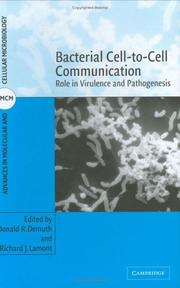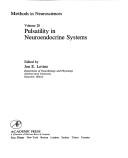| Listing 1 - 10 of 84 | << page >> |
Sort by
|
Multi
ISBN: 9780128163801 0128163801 9780128161500 0128161507 Year: 2019 Publisher: London, United Kingdom : Academic Press, an imprint of Elsevier,
Abstract | Keywords | Export | Availability | Bookmark
 Loading...
Loading...Choose an application
- Reference Manager
- EndNote
- RefWorks (Direct export to RefWorks)
Gap Junction Structure and Chemical Regulation: Direct Calmodulin Role in Cell-to-Cell Channel Gating describes and discusses the findings of major studies conducted during the past century on the structure and chemical regulation of direct cell-to-cell communication via gap junction channels. Chapters bring together important findings on direct cell communication, from its history, to its structure and regulation. These channels are essential for normal organ function, and mutations in their protein (connexin) cause various diseases. The book is useful for established investigators who need a review on the field and young investigators who need a thorough resource for study and comprehension.
Gap junctions (Cell biology) --- Connexins. --- Calmodulin. --- Gap Junctions --- Cell Communication. --- chemistry.
Periodical
Abstract | Keywords | Export | Availability | Bookmark
 Loading...
Loading...Choose an application
- Reference Manager
- EndNote
- RefWorks (Direct export to RefWorks)
Cell interaction --- Cellular signal transduction --- Cell interaction. --- Cell Communication --- Cellules --- Transduction du signal cellulaire --- Interaction --- Interaction.
Book
ISBN: 9535153277 9535107925 Year: 2012 Publisher: IntechOpen
Abstract | Keywords | Export | Availability | Bookmark
 Loading...
Loading...Choose an application
- Reference Manager
- EndNote
- RefWorks (Direct export to RefWorks)
The book Cell Interaction focuses on various processes that occur within and outside the cells. Cell interactions are important for functioning of many organ systems: cell adhesion, tissue development, cellular communication, inflammation, tumor metastasis, and microbial infection. Key features include developmental cell interactions, immune and neural cell interactions, cell interactions in normal and disease conditions and advanced level methods to evaluate cell interactions. This book will be a significant resource to all scientists and physicians who are intended to explore more on cells.
Cell interaction. --- Cell-cell interaction --- Cell communication --- Cellular communication (Biology) --- Cellular interaction --- Intercellular communication --- Cellular control mechanisms --- Cytology
Periodical
Abstract | Keywords | Export | Availability | Bookmark
 Loading...
Loading...Choose an application
- Reference Manager
- EndNote
- RefWorks (Direct export to RefWorks)
Histology. Cytology --- Cell interaction --- Cellules --- Cell Communication --- Periodicals. --- Interaction --- Périodiques --- Cell Communication. --- Cell interaction. --- Cell-cell interaction --- Cell communication --- Cellular communication (Biology) --- Cellular interaction --- Intercellular communication --- Cell Interaction --- Cell-to-Cell Interaction --- Cell Communications --- Cell Interactions --- Cell to Cell Interaction --- Cell-to-Cell Interactions --- Communication, Cell --- Communications, Cell --- Interaction, Cell --- Interaction, Cell-to-Cell --- Interactions, Cell --- Interactions, Cell-to-Cell --- cellular communications --- cell signalling --- cell behaviour --- Cellular control mechanisms --- Biology. --- Human medicine
Book
ISBN: 1789857805 1789857791 1839620870 Year: 2019 Publisher: IntechOpen
Abstract | Keywords | Export | Availability | Bookmark
 Loading...
Loading...Choose an application
- Reference Manager
- EndNote
- RefWorks (Direct export to RefWorks)
This book is an interdisciplinary effort to understand the evolution of communication from cells to societies, both in living organisms and in non-living ones, such as designed or emergent systems from socio-technological innovations (i.e., digital communication, institutional communication). It aims to provide better understanding of the universal versus contextual patterns of communication that we can potentially classify and identify if we look deeper into the history and evolution of this phenomenon at large. Novel research from a variety of disciplines, such as information theory, biology, linguistics, culture and social science that take a complex perspective is being explored, for an integrated understanding of what communication is at a fundamental level.
Book
Year: 2014 Publisher: Frontiers Media SA
Abstract | Keywords | Export | Availability | Bookmark
 Loading...
Loading...Choose an application
- Reference Manager
- EndNote
- RefWorks (Direct export to RefWorks)
Short non-coding RNA molecules, microRNAs (miRNAs), post-transcriptionally regulate gene expression in living cells. In recent years, miRNAs have been found in a wide spectrum of mammalian body fluids including blood plasma, saliva, urine, milk, seminal plasma, tears and amniotic fluid as extracellular circulating nuclease-resistant entities. The changes in miRNA spectra observed in certain fluids correlated with various pathological conditions suggesting that extracellular miRNAs can serve as informative biomarkers for certain diseases including cancer. However, the mechanism of generation and a biological role of extracellular miRNAs remain unclear. The current theories regarding extracellular miRNA origin and function suggest that these miRNAs can be either non-specific 'by-products' of cellular activity and cell death or specifically released cell-cell signaling messengers. The goal of this Research Topic is to bring together up-to-date knowledge about the extracellular miRNA and its role in disease diagnostics and, possibly, inter-cellular communication.
MicroRNA. --- Blood plasma. --- Blood --- Genetics. --- Epigenetics. --- Diseases. --- extracellular miRNA --- exosomal miRNA --- blood plasma --- blood serum --- circulating miRNA --- Argonaute Proteins --- cell-cell communication --- biological fluids
Periodical
Abstract | Keywords | Export | Availability | Bookmark
 Loading...
Loading...Choose an application
- Reference Manager
- EndNote
- RefWorks (Direct export to RefWorks)
Prostaglandins --- Lipids --- Prostaglandines --- Lipides --- Lipids. --- Prostaglandins. --- Lipid Metabolism. --- Cell Communication. --- Metabolism --- Périodiques. --- Métabolisme --- Metabolism. --- Cell Communication --- Lipid Metabolism --- Lipins --- Lipoids --- Metabolism, Lipid --- Cell Interaction --- Cell-to-Cell Interaction --- Cell Communications --- Cell Interactions --- Cell to Cell Interaction --- Cell-to-Cell Interactions --- Communication, Cell --- Communications, Cell --- Interaction, Cell --- Interaction, Cell-to-Cell --- Interactions, Cell --- Interactions, Cell-to-Cell --- Lipid metabolism --- metabolism --- Prostanoids --- Biomolecules --- Steroids --- Inflammation --- Mediators --- Cell interaction. --- Cellules --- Periodicals. --- Interaction. --- Métabolisme. --- Cell-cell interaction --- Cell communication --- Cellular communication (Biology) --- Cellular interaction --- Intercellular communication --- Cellular control mechanisms
Book
ISBN: 163485716X 9781634857161 9781634857017 1634857011 Year: 2016 Publisher: New York
Abstract | Keywords | Export | Availability | Bookmark
 Loading...
Loading...Choose an application
- Reference Manager
- EndNote
- RefWorks (Direct export to RefWorks)
Cell interaction. --- Cellular signal transduction. --- Cellular information transduction --- Information transduction, Cellular --- Signal transduction, Cellular --- Bioenergetics --- Cellular control mechanisms --- Information theory in biology --- Cell-cell interaction --- Cell communication --- Cellular communication (Biology) --- Cellular interaction --- Intercellular communication

ISBN: 9780511541506 9780521846387 0511135084 9780511135088 0521846382 0511137257 9780511137259 0511134355 9780511134357 0511541503 1107152372 1280347082 9786610347087 051120146X 0511311672 9781107152373 9781280347085 6610347085 9780511311673 Year: 2006 Publisher: Cambridge New York Cambridge University Press
Abstract | Keywords | Export | Availability | Bookmark
 Loading...
Loading...Choose an application
- Reference Manager
- EndNote
- RefWorks (Direct export to RefWorks)
Many bacterial diseases are caused by organisms growing together as communities or biofilms. These microorganisms have the capacity to coordinately regulate specific sets of genes by sensing and communicating amongst themselves utilizing a variety of signals. This book examines the mechanisms of quorum sensing and cell-to-cell communication in bacteria and the roles that these processes play in regulating virulence, bacterial interactions with host tissues, and microbial development. Recent studies suggest that microbial cell-to-cell communication plays an important role in the pathogenesis of a variety of disease processes. Furthermore, some bacterial signal molecules may possess immunomodulatory activity. Thus, understanding the mechanisms and outcomes of bacterial cell-to-cell communication has important implications for appreciating host-pathogen interactions and ultimately may provide new targets for antimicrobial therapies that block or interfere with these communication networks.
Bacteria --- Cell interaction. --- Cellular signal transduction. --- Cellular information transduction --- Information transduction, Cellular --- Signal transduction, Cellular --- Bioenergetics --- Cellular control mechanisms --- Information theory in biology --- Cell-cell interaction --- Cell communication --- Cellular communication (Biology) --- Cellular interaction --- Intercellular communication --- Bacterial physiology --- Physiology --- Physiology.

ISBN: 012185289X 9780121852894 148328834X Year: 1994 Publisher: San Diego, California : Academic Press,
Abstract | Keywords | Export | Availability | Bookmark
 Loading...
Loading...Choose an application
- Reference Manager
- EndNote
- RefWorks (Direct export to RefWorks)
Pulsatility is now recognized as a nearly ubiquitous functional feature of neuroendocrine systems. This volume presents a comprehensive guide to the established and emerging technologies being used to study the perplexing phenomenon of pulsatility. Molecular, cellular, physiological, and mathematical approaches are described in detail.Comprehensive protocols included for the study of* In vitro methods for studying neuroendocrine pulsatility* In vivo sampling and recording procedures for monitoring pulsatility in several species* Improved quantitative and analy
Paraneurons. --- Biological rhythms. --- Cell interaction. --- Cell-cell interaction --- Cell communication --- Cellular communication (Biology) --- Cellular interaction --- Intercellular communication --- Cellular control mechanisms --- Biological clocks --- Biology --- Biorhythms --- Endogenous rhythms --- Living clocks --- Rhythms, Biological --- Chronobiology --- Cycles --- Pacemaker cells --- Neuroendocrine cells --- Neurons --- Chromaffin cells --- Periodicity
| Listing 1 - 10 of 84 | << page >> |
Sort by
|

 Search
Search Feedback
Feedback About UniCat
About UniCat  Help
Help News
News